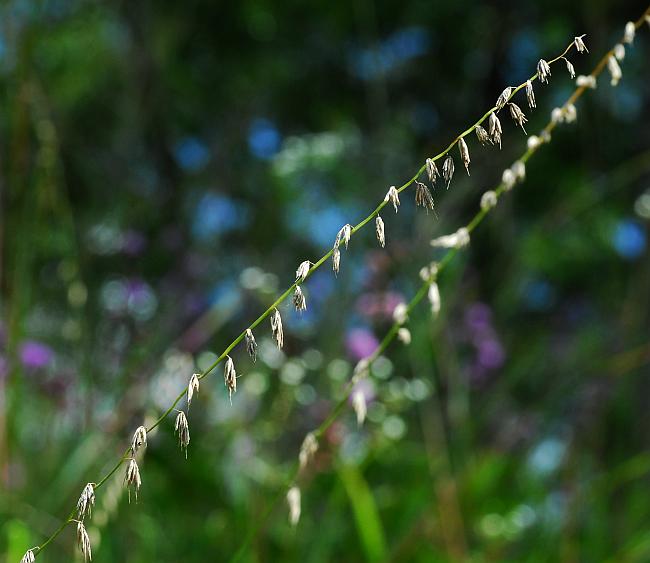Bouteloua curtipendula (Michx.) Torr.
Sideoats Grama

Native
CC = 7
CW = 5
MOC = 68
© SRTurner
Bouteloua curtipendula (Michx.) Torr.Sideoats Grama | |
 |
Native CC = 7 CW = 5 MOC = 68 |
© SRTurner |
|
Family - Poaceae/Cynodonteae Habit - Perennial grass with creeping rhizomes, forming few-stemmed clumps. Stems - Flowering stems 30-100 cm long, erect or sometimes somewhat arched toward the tip, glabrous or minutely hairy at nodes. Leaves - Leaf sheaths glabrous or the lowermost sparsely hairy. Leaf blades 5-35 cm long, 3-7 mm wide, flat, glabrous except sparsely pubescent on the margins near the base with short, pustular-based hairs. Ligule a line or band of hairs.
Inflorescences - Elongate, linear, with 30-70 spikes, these spreading to angled downward, shed intact as a unit, leaving the main axis of the inflorescence naked after the spikelets have been shed. Spikes 8-15 mm long, with 2-8 spikelets, the axis of the spike not extended past the uppermost spikelet. Flowers - Spikelets with 1 perfect floret below usually 1 or 2 reduced, sterile florets. Lower glume 3-4 mm long, linear or awnlike, glabrous or roughened. Upper glume 4.0-7.5 mm long, narrowly lanceolate, glabrous or roughened. Fertile lemma 3-7 mm long, lanceolate, glabrous or roughened, the central nerve extended into a short awn to 1 mm long at the tip. Sterile lemma sometimes reduced to short awns or more commonly with the body 0.5-3.5 mm long, the central nerve extended into an awn 1.5-5.0 mm long, the lateral nerves usually also extended into short awns. Anthers 1.5-3.0 mm long, reddish orange to orange, rarely yellow or purple.
Fruits - Fruits narrowly oblong-elliptic, 3.4-3.8 mm long. Flowering - July - September. Habitat - Glades, upland prairies, savannas, rocky openings of forests, roadsides, railroads, on calcareous soils. Origin - Native to the U.S. and Latin America. Lookalikes - None close. Other info. - This species can be found throughout much of Missouri, less commonly in the northwestern and bootheel portions of the state. Beyond Missouri its range comprises a wide swath across the central continental U.S., with additional scattered populations farther east. The plant can be easily identified while in flower from its pendulous spikelets. The pustular bases of the hairs at the base of the leaf blade are another good characteristic to look for. Photographs taken at near Big Spring, Carter County, MO., 7-26-04 (DETenaglia); also at Little Lost Creek Conservation Area, Warren County, MO, 9-6-2016, and Ellis Island, near West Alton, St. Charles County, MO, 7-3-2017 (SRTurner). |